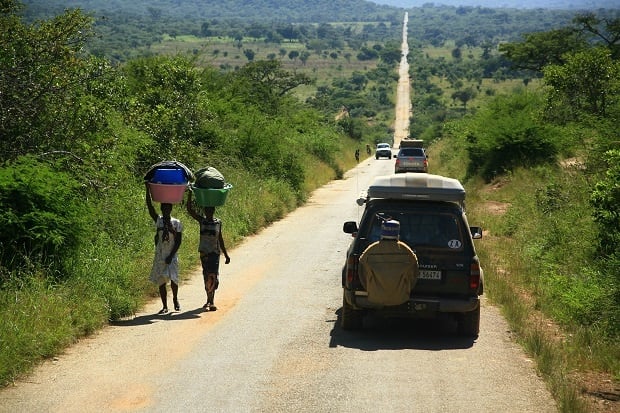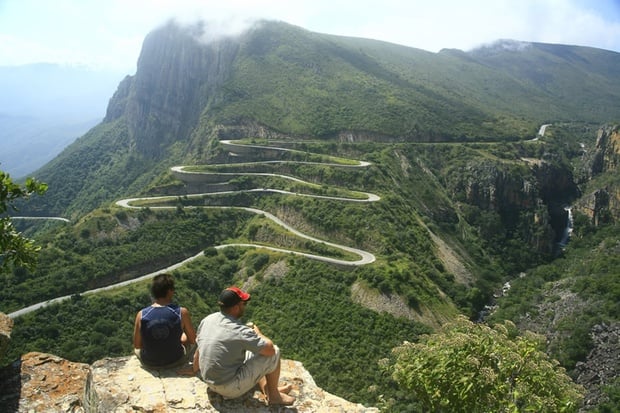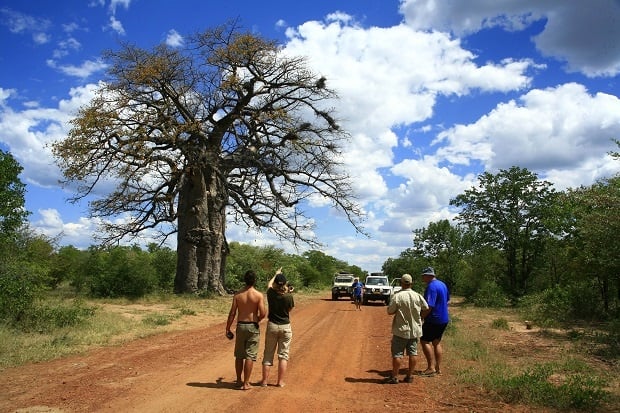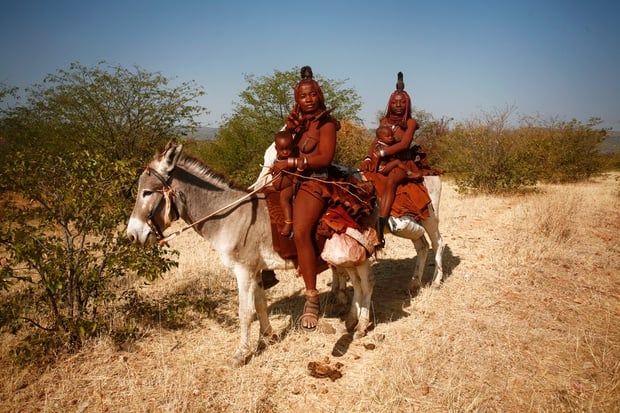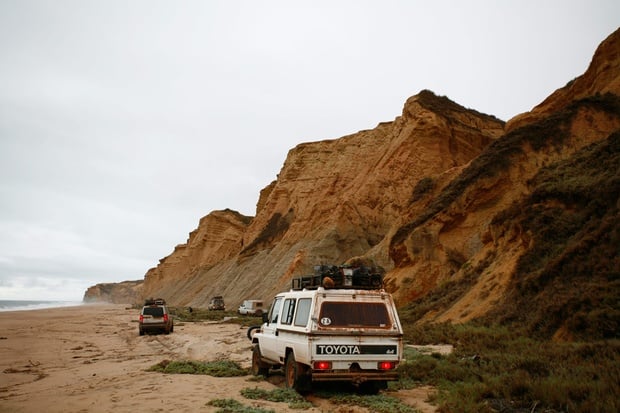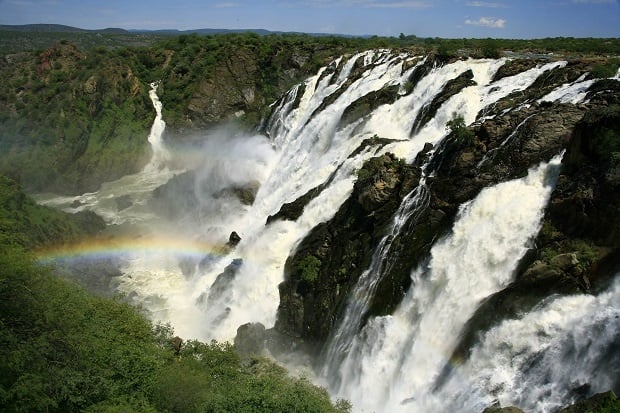Faces de Angola
This tour is going to be an expedition. The itinerary serves as an indication of the route, but due to bad road conditions and unforeseen circumstances the day-to-day programme may be adjusted.
- Pedras Negras
- Kwanza River
- Leba Pass
- Calundula Waterfall
Overview
“It is the voyage not the ship that matters” - famous Angolan Proverb.
Although we are not going to travel by ship to Angola, the voyage (journey) that awaits you will surely be epic … and that is what matters. During this 15-day journey covering 4 200 km in Angola you will be mesmerized by landscapes, different climates, rivers, cultures, and colours. You will drive over high mountains, across vast open plains, see white beaches and be engulfed by thick tropical rainforests. Angola has it all, as if each of its eighteen provinces is a different country.
Much of the landscape is dramatic, with plunging waterfalls, bizarre rock formations and deep gorges. Leba Mountain in the Huila Province rises out of the Tundavala gorge to give stunning views of the vast Namib Desert. It is not often that you will encounter huge baobab forests, mighty rivers, the legacy of Portuguese culture, impressive waterfalls, and secluded little beaches along the Atlantic, all on one tour.
Prepare yourself for a road trip of a lifetime!
Please note that the itinerary for Angola serves as an indication of the route. It will be adjusted according to local conditions and the condition of roads. There are almost no tourist facilities in the areas we will travel through, and most of the nights we will spend wild camping. It is impossible to plan exactly the distances per day and we will set up camp every day as progress allows.
Itinerary
DAY 01: Group meets in Rundu
Plan your trip to arrive in Rundu no later than 17h00 on this day. Over dinner you will meet the guide team as well as your fellow tour members. The guides will also give a tour briefing.
O/N Camping: Kaisosi River Lodge. Dinner.
(Upgrade to lodge accommodation for own account. Please ask our office to assist with upgrades.)
DAY 02 - 04: Border – Menongue – source of the Cubango River
We will make an early start for the Katwitwi border post. Crossing the border into Angola is always a time-consuming process. One of our guide team is fluent in Portuguese and will assist to ensure that this process is as hassle-free as possible.
Once in Angola the road follows the mighty Cubango River. The road is in bad condition with lots of potholes, but this will gradually improve. Currently, the road is under construction with one of the contractors being the former Springbok Rugby captain, Gary Teichman.
For 44-years Angola was a war zone (ended in 2003). The area that we will pass through in the next couple of days was a hot spot during the war. The South African forces were active in the area with a number of operations. War remnants are being removed, but you will still see some weaponry along the roadside.
Our objective is to reach the source of the Cubango River in 3 days’ time. On the second day of our journey, we hope to reach the town of Mengongue. Here we will refuel, and you will see the remnants of buildings that were affected by the war. Interestingly enough people still live in these buildings. 250 km east of Menongue is the town of Cuito Cuanavale. The last major battles of the Angolan Bush War (Operations Hooper, Pecker and Displace) were fought in the area around Cuito Cuanavale. Menongue was strategic in these battles as it was the main supply line to Cuito for the Swapo and Cuban Forces. To this day both Swapo and the South African Forces claim victory for these battles.
At the end of Day 3 we might reach the area of the source of the Cubango River. We will set up a bush camp about 60 km from the specific spot where the source of the river is in the Angolan Highland. The average rainfall here is annually about 1 800 mm. Here is also an important watershed. To the North is the source of tributaries of the Kongo River, on the east the source of the tributaries of the Zambezi and to the south the origin of the Cubango River
O/N Wild camping.
Breakfast and Dinner.
DAY 05 - 06: Via Huambo to Waka Kungo and the Angola COFFEE producing area
From the Angola Highlands we are heading west to the city of Huambo. Huambo is the second largest city in Angola and was formally known as Nova Lisboa. Huambo was at one point during the war a stronghold of the guerrilla fighter, Jonas Savimbi. From here we will start to encounter more traffic. We are heading to the town of Waka Kungo – a beautiful and very fertile area. The next day we will pass the famous Bridge 14 (Brug 14), over the Nhia River. In 1975 during Operation Savannah the South African forces pushed the Cuban forces back over the Nhia River after the famous Battle of Bridge 14.
The MPLA forces sabotaged the bridge and destroyed it. Within no time, the South African forces had it rebuild. It was important to have a bridge over the river as the main battlefield was along the road due to the impenetrable marshy conditions of the area.
We will drive over a new bridge that crosses the Nhia River, but the remains of the old steel bridge that was built by the South African forces are still visible.
We should also be able to see white and red markers on trees which indicates the possibility of minefields beyond the trees. These are the remains left by demining teams when cleaning the area. There are still demining teams working on removing some of the last mines that can still be found in remote parts of Angola.
We are on our way to a traditional deserted Coffee Farm and will start seeing old coffee plantations. Coffee is one of Angola’s most important agricultural products. Prior to independence in 1975, coffee production in Angola reached about 230 000 tons per year, making Angola the fourth largest coffee-producing nation in the world. You will have the chance to buy some local coffee, subject to availability.
O/N Wild camping.
Breakfast and dinner.
Possibility to upgrade to rooms for night at coffee farm (upgrade own account).
DAY 07 - 09: Pedras Negras, Kalandula Waterfalls, Luanda
We leave the coffee plantations behind to travel to Pedras Negras. Pedra Negras is arguably one of the most beautiful places in Angola, in the heart of the Angolan Highlands. Here you will find a series of mysterious rock formations called the Black Rocks. Geologically, the rocks are a mystery – they are hard sedimentary conglomerates but are out of character with the surrounding topography. Many of these rock formations are shaped in the form of animals, standing high above the flat African Savanna. We will hike a short distance up a hill for a beautiful view of the surroundings. En route we will stop to show you footprints imprinted in the stones. This supports the myth of a princess that bathed and when soldiers approached her, she fled.
We continue our journey to the north towards the Calandula Falls. The Calandula Falls is an awe-inspiring sight and said to be Africa’s second or third largest waterfall. The 105-meter-high / 400 m wide waterfall is a spectacular site and take one’s breath away when looking at the mighty force with which water plunges down to form mist giving the area a mystical feel. Our campsite tonight is close to the Calandula Falls. (Upgrading is possible to hotel rooms at own cost).
Our aim is to reach Luanda on day 9 of our journey. The scenery alongside the road from Calandula to Luanda is beautiful with massive baobab trees. By midday we will reach Barra Do Dande, 30 km north of Luanda. This is also the location of the “famous” shipwreck graveyard: a barren with as many as 50 rusting ships on or near the beach. It is like being on the set of a post-apocalyptic Hollywood thriller. There are two myths regarding the reason for the shipwrecks, an Angolan version and one by the Portuguese. The Angolan version is that the ships were not seaworthy and had to be left where they were. The Portuguese version is that they stranded the ships when they were forced to leave them behind when they fled the country at the end of the colonial era.
Our campsite for the night will be in the vicinity of Barra do Dande, on a hill with a beautiful view of the ocean.
O/N Wild camping.
Breakfast and dinner.
Possibility to upgrade to rooms for night at Calandula (upgrade own account).
DAY 10 - 14: Luanda to Namibe
We have reached the beautiful Angolan coastline here at Luanda. It is also the turning point of the tour and for the next 5 days, we will explore the stunning coastline. But first we must tackle the traffic of Luanda. We will take the Ring Road around the city to avoid the traffic jams in the city center. It is a busy city with a population of between 5 and 8 million. The gap between poor and rich is huge and one will experience some of this. The daughter of ex-President dos Santos, Isabel dos Santos, became the richest woman in Africa in 2020. We will stop at a big shopping complex to refuel and replenish stock for the next couple of days. Our destination is Kwanza Lodge, a beautiful lodge on the banks of the Kwanza River which was built by a South African, Rico Sakko. Tonight, you will be spoiled with lodge accommodation (DBB – drinks for your own account). If the weather permits, we will be able to book a boat trip (own account) on the mighty Kwanza River either the afternoon or the next morning before we depart for Seles.
Working our way south via Sumbe, crossing the Keve River, we reach the Kumbira Forest. Kumbira Forest is under government protection and serves as an educational example to the locals of how-to live-in harmony with the forest and not to destroy it. This is a must see. We will set up camp high on top of a mountain, promising to deliver quite a sight.
From Seles we travel to Lobito which dates back to 1843. Lobito is an important seaport and the beginning (or end) of the Benguela railway line. During the colonial era the town was the playground of rich Portuguese and the remains of some of these beautiful holiday houses are evidence of this. The town was well-known for its carnivals and prosperity.
Today Lobito represents a very modern part of Angola with many ships and oil rigs in the harbour. The peninsula with its nightlife and variety of small restaurants makes it ideal for a stopover. Here you will receive a chance to relax on the beach and enjoy the atmosphere. To experience the rhythm and vibrance of the city dinner on this night will be in a local restaurant (dinner will be for own account).
Leaving the boundaries of city life, we head south. We leave the lush and green mountains behind, which make place for a more arid environment. The coastline is really beautiful. There will be an opportunity for anglers to wet their fishing lines if the tide allows. The beauty and natural wonders of this area is something to discover. One of our overnight camps will be as close to the beach as possible.
Our aim is to reach the beautiful harbour city of Namibe. The city was founded in 1842 and until 1985 had the name of Mocamedes. Namibe is officially the start (or end?) of the Namib Desert. It has a dry climate with arid vegetation. Namibe has the third largest port in Angola, after Luanda and Lobito. It is also the terminus of the Namibe Railway. The town has a gigantic market where you can buy nearly anything. You will have the opportunity to spend some time shopping here. Our overnight location tonight will be a wild camp, but extremely special.
O/N Wild camping, one lodge night.
Breakfast and dinner, except dinner in Lobito for own account.
DAY 15: Namib, Leba Pass, Humpata Christo Rei, Tundavala
It is time to bid the coastline of Angola farewell as our journey to the Namibian border begins. The next 2 days before we reach Ruacana, on 25 May, will be full of highlights. First on the agenda
is the spectacular Leba Pass with its awesome hairpin bends and waterfalls. It is a road construction masterpiece with an elevation of 1 000 m within 15 km. The pass is the gateway from the coast to the interior and the city of Lubango. During the Bush War the South-African force had several attempts to sabotage the road that would have cut off the supply line from the coast, but they never succeeded. It is believed that the pass was designed by a Portuguese lady who passed away on the day that the construction of the road was completed.
After the Leba Pass it is about 20 km before reaching the town of Humpata. This town has a strong South African connection as it was here where the Dorsland Trekkers settled in 1881. Humpata was a prosperous little town where the South Africans enjoyed farming the fertile soil. Visiting the Dorsland Trekker cemetery will be memorable as you will recognise surnames like Alberts, van der Merwe and de Jager.
The Christ the Redeemer statue is our next sightseeing stop. The Monumento do Christo Rei keeps a watchful eye over the city of Lubango. The white marble statue is 30 meters high and situated on a hill near the city. The statue is a smaller version of the one in Rio de Janeiro and Lisbon.
Our last stop for the day is at Tundavala, 5 km outside of Lubango. Standing on this cliff you can imagine that the earth has split open here. On a clear day you can see the Namib Desert. It is a beautiful tranquil place, but 50 years ago during the Angolan Civil War MPLA soldiers executed deserters and dispose of the bodies by throwing it in the gorge. The gorge at Tundavala drops 1,200 m to the floor of the plateau which creates a very impressive view.
Weather permitting our last camp in Angola will be near Tundavala promising an amazing view. If the weather does not play its part, we will look for an alternative. On our last night there is a possibility for a last restaurant dinner (own account).
O/N Wild camping.
Breakfast and dinner. (Possibility of last dinner at a restaurant for own account).
DAY 17: Depart Ruacana for your homebound journey
Check out and depart home at your own time.
END OF TOUR
DAY 16: Ruacana
Our journey is drawing to a close, but a final stretch of about 430 km waits before we will enter Namibia at Ruacana. From Lubango, we will head south towards the province of Cunene at a more leisurely pace. We will cross the border late afternoon after crossing the Cunene River. You will be back in Namibia, and it is time to say sad farewells with our last dinner tonight at Eha lodge, Ruacana.
O/N: Camping at Eha Lodge (possibility to upgrade at own cost).
Breakfast and Dinner.
Dates
2024 Tour Dates:
- 10 - 26 May 2024 (Fully booked)
- 06 - 22 June 2024
Rates
LAND PACKAGE COST:
Per adult: R29 950 **
Per child 6 – 17 years: R11 900
Single supplement available on request.
This tour operates with a minimum of 14 adults.
Prices for concession fees, taxes, park fees and fuel may be changed without prior notice. This is beyond our control and any increase levied will be for the traveller’s account.
Included
- Meals as per the programme (dinner breakfast)
- Experienced guides and logistical team with own vehicles
- Portuguese speaking guide
- Lodging:
- Dinner and camping at Kaisosi River Lodge (upgrading is possible at own cost)
- Kwanza Lodge 70 km south of Luanda on DBB basis**
- Last evening at Eha lodge, Ruacana: dinner and camping (upgrading is possible at own cost)
- Two-way radios for vehicles
- All Camping fees
- Park fees
- Portable camp showers and toilets for all wild camping nights
** We have included an overnight stay at Kwanza Lodge based on 2023 rates. When the 2024 rates are published the current rate will be adjusted to reflect the 2024 Kwanza Lodge rate.
Excluded
TOUR EXCLUDES:
- All vaccinations, like Yellow Fever and malaria precaution, etc.
- Border fees for Angola – approximately R600 depending on the exchange rate.
- Comprehensive travel and medical insurance.
- Vehicle insurance.
- Beverages and water.
- Lunches.
- Snacks.
- Upgrade to lodge accommodation where specified in the programme.
- Meals in restaurants where specified in the programme.
- Items of personal nature.
- Visa cost (if applicable; South African passport holders do not require a visa).
PLEASE ENSURE YOU HAVE SUFFICIENT MEDICAL AND TRAVEL INSURANCE
CLIENTS NEED TO SUPPLY:
- Tents, mattress, sleeping bag/ blanket, chairs (folding table - small)
- Own cutlery and crockery
- Two large bags of wood per vehicle. (In the northern parts of Angola, you will struggle to find dry wood)
- Forty litres of water of which twenty litres will be given to the guide for use in the kitchen and the remainder is for showering.
- Additional water for drinking.
- Beverages, snacks, and lunch.
- Strong garbage bags – Clients will have to carry their own garbage/waste.
- Sufficient fuel – there will be fuel stops en-route. Make sure your vehicle can cover 800 km in normal conditions.
- Personal items such as medication, sunblock, flashlight, camera, batteries etc.
Reservations
Fill out the form below to request a full itinerary.



